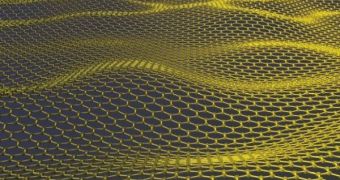Experts at the Kansas State University (KSU) have recently announced that they managed to augment the electric properties of the carbon compound graphene, by adding gold nanoflakes to its surface. They argue that the addition of the so-called snowflake-shaped gold nanostars (SFGN) created a uniformly distributed “chain of islands” on the surface of the one-atom-thick material. They say that the graphene is indispensable to the process, and that gold nanostars cannot be obtained any other way, ScienceDaily reports.
In order to obtain the new structures, the experts simply had to deposit graphene oxide sheets into a gold ion solution, and wait for nature to take its course. “Graphene-derivatives act like swimming molecular carpets when in solution and exhibit fascinating physiochemical behavior. If we change the surface functionality or the concentration, we can control their properties,” KSU Assistant Professor of Chemical Engineering and graphene expert Vikas Berry explains. He collaborated with KSU doctoral student in chemical engineering Kabeer Jasuja for the innovation.
The two found that, after being immersed in the gold solution, the surface of the graphene did not look quite like they had expected. Rather than seeing an evenly distributed layer of gold on the surface of the carbon, they noticed only small “islands” of the stuff. “So we started exploring how these gold nanostars are formed. We found out that nanostars with no surface functionality are rather challenging to produce by other chemical processes. We can control the size of these nanostars and have characterized the mechanism of nucleation and growth of these nanostructures. It's similar to the mechanism that forms real snowflakes,” the expert adds.
Berry says that graphene is indispensable to the formation of the nanostars because, otherwise, the gold would simply clump and deposit as large chunks, rather than as individual islands. “But the graphene helps in stabilizing the gold. This makes the nanostars more useful for electronic applications,” he says. Details of the investigation appear in the latest issue of the respected scientific journal ACS Nano. “Now we can use the harsh chemicals on graphene oxide embedded with gold to obtain graphene with gold islands. Then we can use these gold islands to functionalize DNA,” he concludes.

 14 DAY TRIAL //
14 DAY TRIAL //